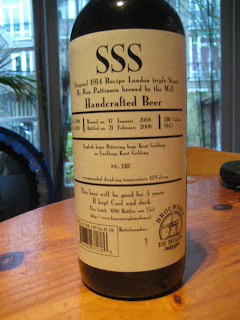 Back to "Die Herstellung Obergähriger Biere" (by Dr. Franz Schönfeld, 1902). How can I stay away from a book so full of laughs?
Back to "Die Herstellung Obergähriger Biere" (by Dr. Franz Schönfeld, 1902). How can I stay away from a book so full of laughs?Pages 65 and 66 describe various special types of Süssbier ("Sweet Beer"). There's very little left of these styles today. Apart from that one Lichtenhainer. Let's see how much of the translation I can be bothered to type in tonight. I may do a part two tomorrow. Right, here goes . . . .
"Special Beers
In North Germany, especially in port cities, a 9-11º, dark, sweet beer is brewed which, after tun fermentation at 12 - 14º R [15 - 17.5ºC] is lagered in medium-large lagering barrels at 5 - 7º R [6.25 - 8.75ºC] for 14 days, also wood chips are often added to speed clarification, and after being drawn off is enriched with Kräusen.
In Hanover, the very weakly-hopped, sweet Broyhan Bier, using 20% wheat malt, has been brewed for centuries. In contrast to Berliner Weissbier, breweries in the provinces make Weissbier without the use of lactic acid bacteria, is fermented with yeast alone, through lagering at 4 - 6º R [5 - 7.5ºC] and the addition of wood chips it undergoes a long secondary conditioning and clarification, is drawn off clear through a filter and is filled into bottled with a little Kräusen. The beer, which after a while becomes clear, should have a fiery brilliance and foam in the glass. The use of some wheat malt or lightly-smoked barley malt makes this beer taste particularly piquant and refreshing. In Bavaria, especially Munich, a Weissbier is brewed from wheat malt and barley malt, which is similar to provincial Weissbier. The use of lightly-smoked barley malt is also found in other beers, for example in Lichtenhainer Bier, a very weakly-hopped beer of about 8º made from light barley malt."
There's some interesting stuff (what an extensive vocabulary I have) in there. It seems to be saying that Bavarian Weissbier was generally similar to Weissbier from other regions.
It always makes my day when I find a new mention of Broyhan or Lichtenhainer. Unfortunately, it only talks about Broyhan in the vaguest terms. Bit of wheat, not much hops. I already knew that much. Irritatingly, though the description of Lichtenhainer is more specific, it contradicts other sources. Earlier texts say that it was hoppy and very smoked. They do agree on an FG of about 8º Balling (about 1032).
I'm pretty sure that "Spähnung" means adding wood chips. It wouldn't be the first time I'd been mistaken, so I thought I'd mention it. Let me know if I'm wrong. In fact, feel free to check the whole translation. That's one of the reasons I've included an image of the original. And to let you see how much fun it is reading effing gothic typefaces.


















































































